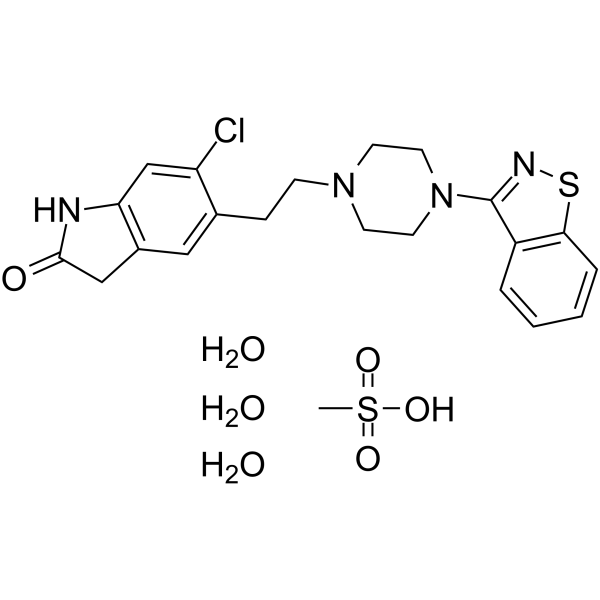199191-69-0
| Name | ziprasidone mesylate trihydrate |
|---|---|
| Synonyms |
5-(2-(4-(1,2-benzisothiazol-3-yl)-1-piperazinyl)ethyl)-6-chloro-1,3-dihydro-2h-indol-2-one
anhydrous 5-(2-(4-(1,2-benzisothiazol-3-yl)-1-piperazinyl)ethyl)-6-chloro-1,3-dihydro-2H-indol-2-one Ziprasidone Ziprasidone mesilate 2H-INDOL-2-ONE,5-[2-[4-(1,2-BENZISOTHIAZOL-3-YL)-1-PIPERAZINYL]ETHYL]-6-CHLORO-1,3-DIHYDRO-,MONOMETHANESULFONATE,TRIHYDRATE [14C]-Ziprasidone 5-[2-[4-(1,2-benzisothiazol-3yl)-1-piperazinyl]ethyl]-6-chloro-1,3-dihydro-2h-indol-2-one mesilate [3H]-Ziprasidone Ziprasidone mesylate trihydrate 5-{2-[4-(1,2-Benzothiazol-3-yl)-1-piperazinyl]ethyl}-6-chloro-1,3-dihydro-2H-indol-2-one methanesulfonate hydrate (1:1:3) 2H-Indol-2-one, 5-[2-[4-(1,2-benzisothiazol-3-yl)-1-piperazinyl]ethyl]-6-chloro-1,3-dihydro-, methanesulfonate, hydrate (1:1:3) ZIPRASIDONE MESYLATE |
| Description | Ziprasidone (CP-88059) mesylate trihydrate is an orally active combined 5-HT and dopamine receptor antagonist[1]. Ziprasidone mesylate trihydrate has affinities for Rat D2 (Ki=4.8 nM), 5-HT2A (Ki=0.42 nM) and 5-HT1A (Ki=3.4 nM)[1]. |
|---|---|
| Related Catalog | |
| Target |
Rat 5-HT2 Receptor:0.42 nM (Ki) Rat 5-HT1A Receptor:3.4 nM (Ki) Rat D2 Receptor:4.8 nM (Ki) |
| In Vitro | Ziprasidone mesylate trihydrate (0-500 nM, 150 seconds) blocks wild-type hERG current[2]. Cell Viability Assay Cell Line: HEK-293 cells[2] Concentration: 0-500 nM Incubation Time: 150 seconds Result: Blocked wild-type hERG current in a voltage- and concentration-dependent manner (IC50 = 120 nm). |
| In Vivo | Ziprasidone mesylate trihydrate (oral gavage; 20 mg/kg; once daily; 7 weeks) results in weight loss, low level physical activity, high resting energy expenditure and greater capacity for thermogenesis when subjected to cold[3]. Animal Model: Eight-week-old female Sprague-Dawley rats weighing 200 to 250 g[3] Dosage: 20 mg/kg Administration: Oral gavage; 20 mg/kg; once daily; 7 weeks Result: Gained significantly less weight (P = 0.031), had a lower level of physical activity (P = 0.016), showed a higher resting energy expenditure (P < 0.001), and displayed a greater capacity for thermogenesis when subjected to cold (P < 0.001). |
| References |
| Boiling Point | 554.8ºC at 760 mmHg |
|---|---|
| Molecular Formula | C22H31ClN4O7S2 |
| Molecular Weight | 563.087 |
| Exact Mass | 562.132263 |
| PSA | 167.15000 |
| LogP | 4.34180 |
| Vapour Pressure | 1.13E-29mmHg at 25°C |
